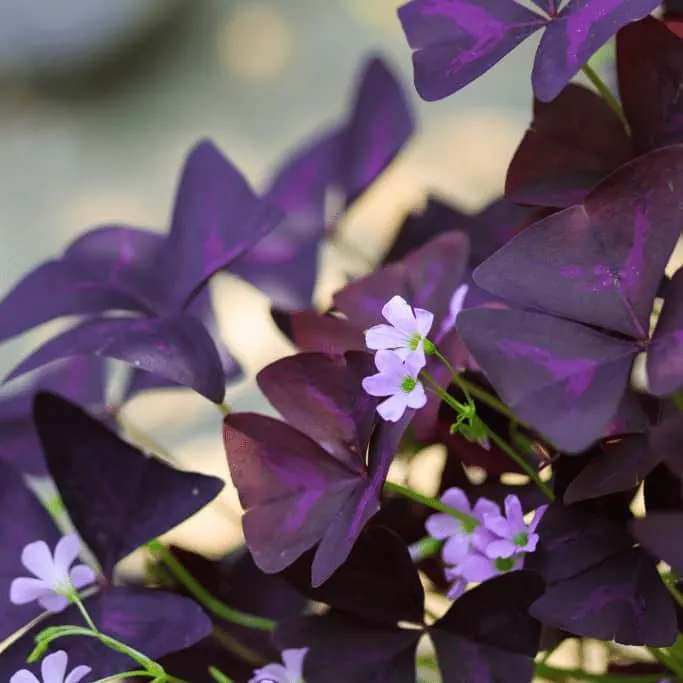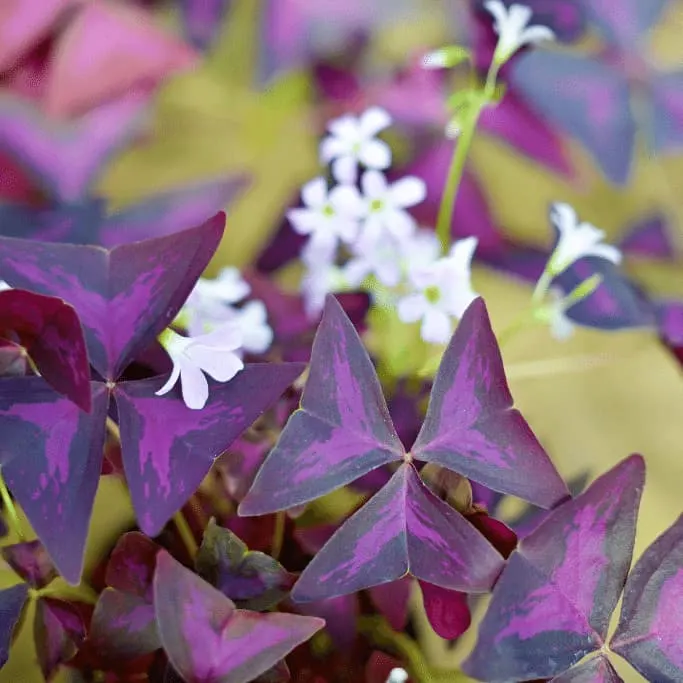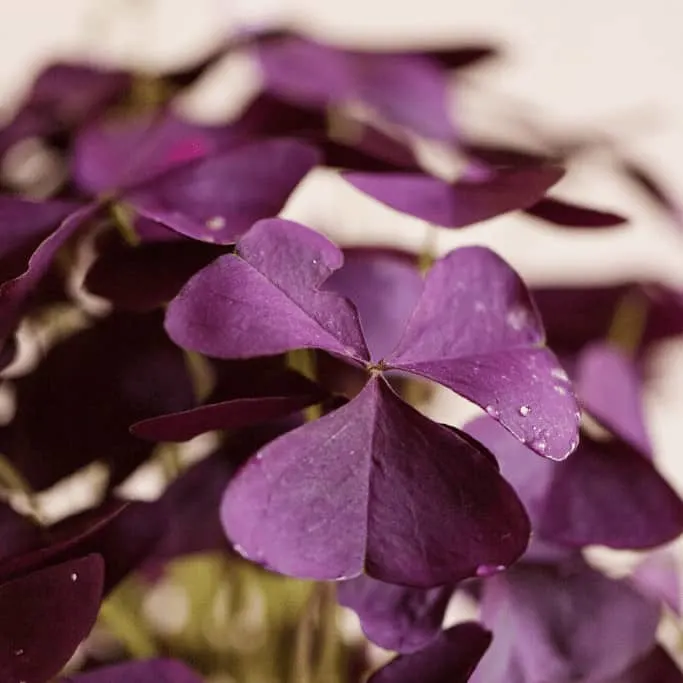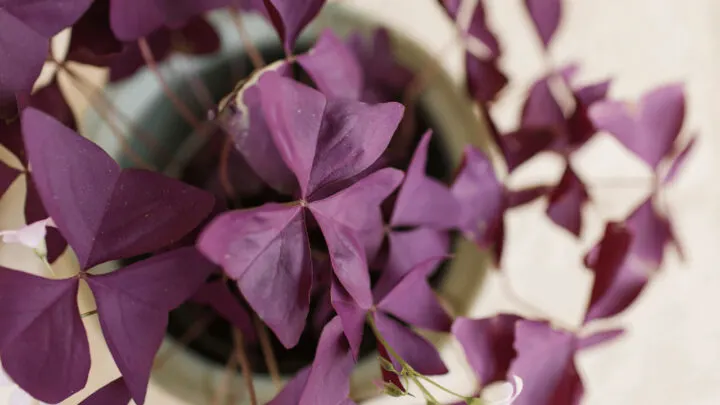Oxalis triangularis or the Purple Shamrock is one such plant.
Being a perennial, this plant is most commonly recognized for its trifoliate leaves that are a striking shade of purple.
This plant is rhizomatous according to the NC State University, meaning that it has a rhizome that is growing in the soil.
Trifoliate simply means that the leaves are divided into three separate sections.
This often confuses others to believe that it is related to the Shamrocks, therefore earning another nickname, the False Shamrock.
In order to keep your Oxalis triangularis plant bold and happy, there is some minimal upkeep.
This guide is made to help you through each step such as any soil, water, and temperature requirements.
You will also learn how to repot these plants and propagate when needed. So how exactly do you keep these plants alive?
Are they poisonous to your animals? All will be answered in this article so that you can own your own Purple Shamrock without worry.
Oxalis triangularis Care
To care for Oxalis triangularis provide it with bright indirect light. Provide a well-draining soil mix consisting of perlite and peat and potting soil. Water when the top inch of the soil almost dries out. Provide it with temperatures between 60 and 80 degrees Fahrenheit (15 to 27 degrees Celsius). A humidity level of around 50% is sufficient. Fertilize every 3-4 weeks with a liquid fertilizer diluted to half strength.

Oxalis triangularis Care Tips
Table of Contents
OXALIS TRIANGULARIS PLANT CARE BASICS
This perennial is labeled by most as being relatively low maintenance.
Those who love their assortment of colors also enjoy the rich purple and black hues that a Purple Shamrock can provide.
Use our care sheet made specifically with your new Oxalis triangularis in mind.
Soil
Oxalis triangularis grows best in a mix of perlite or peat and potting soil. They grow best in soil with a pH between 7.5-8.0 but are not very picky regarding either acidic or alkaline soil.
The foundation for any successful plant can be found in the nutrients of the soil itself.
Pay close attention to the type of soil that you purchase.
Oxalis triangularis prefers to be kept in soil that is well-draining.
In terms of the pH level, they are quite hardy, surviving in pots filled with either acidic or alkaline soil.
If you’re unsure as to whether or not the soil is being drained properly, add some perlite to it.
Light
Oxalis triangularis does best when added to a room with bright indirect light.
Carefully keep them away from areas that are too bright as this will result in burned leaves.
They can handle some bright light, though not for extended periods of time.
The leaves actually can tell you how much light the plant is getting.
They will open up when exposed to the higher end of the spectrum without being too bright.

Oxalis triangularis with its shamrock shaped leaves
Watering
The general rule of thumb is to water Oxalis triangularis once the top inch of the soil almost dries out.
Most members of the Shamrock plant family, or Oxalis, thrive if given a good amount of water.
These plants are found in South America, meaning that they are used to rather moist conditions.
The best way to ensure that your Purple Shamrock lives are to regularly water it without drowning the roots as this may result in root rot.
This is largely due to the bulb that they grow underground.
Temperature
The best temperature for Oxalis triangularis lies between 60 and 80 degrees Fahrenheit (15 to 27 degrees Celsius).
As mentioned earlier, this type of houseplant does well when placed in limited sunlight.
If temperatures dip down below this range, the plant will cease to grow.
If the temperatures surpass 80 degrees Fahrenheit (27 degrees Celsius) is deteriorates as well.
The love if the temperature is more on the cooler side of the range.
Humidity
The average room humidity of around 50% works well for Oxalis triangularis and is sufficient.
Originating from Brazil, you would assume that the False Shamrock plant would need more humidity.
Oxalis that is not provided the right amount of humidity will begin to lose the striking splash of colors that the leaves are so cleverly present.

Oxalis triangularis in bloom
Fertilizer
Fertilize Oxalis triangularis every 3-4 weeks with a liquid fertilizer diluted to half strength.
If you are diligent at keeping the basic needs of your plant met, you may find that less fertilizer goes a long way. This is true.
The Purple Shamrock needs to be fed only once every few weeks, if not sooner depending on the state of your plant.
Be sure to dilute any liquid fertilizer you may have to half strength, just to maintain a healthy plant.
Propagation
Oxalis triangularis can be propagated through separation.
The act of propagating an Oxalis plant is one of the easiest steps for the Purple Shamrock.
There are a few ways in which you can go about propagating your Oxalis, This is typically conquered through separation.
Growth
The typical height for an Oxalis triangularis plant can range between two and 12 inches tall.
It tends to grow at a medium rate. The Purple Shamrock is also extremely hardy, surviving up to the ninth zone in total.

Oxalis triangularis thriving
Potting
Oxalis triangularis needs to be repotted only every few years and will adjust to the pot size it is in.
Some plants quickly outgrow their pots, but not the Purple Shamrock.
This perennial actually grows in a way that is quite compact, meaning that it does not spread out.
It may seem alarming since the new growth is rather quick, but it will slow down and slowly begin to fit the size of the pot you have chosen.
WATERING THE OXALIS TRIANGULARIS PLANT THE RIGHT WAY
As with the majority of plants, it can be all too easy to overwater.
Oxalis triangularis is a delight to take care of, but this does not mean that you shouldn’t incorporate a regular routine of watering without excessive moisture.
WHERE TO WATER
We touched on this earlier, but the Purple Shamrock plant prefers to be placed in soil that can be drained.
Certain soils, such as those with clay will keep the moisture inside where root rot can take place.
When watering your Purple Shamrock, take it to the source.
These houseplants have bulbs, which need water in order to grow.
By watering near the roots, you can ensure that they are properly saturated.
WHEN TO WATER
It’s no secret that the bulbs of a Purple Shamrock plant do well when given adequate moisture, but too much can cause rotting.
The best way to tell if you have enough water is to check the top two centimeters of soil.
If it is dry, you can add more water. If not, give your plant a few days.
The goal is to keep this section of the soil only slightly saturated.
You can expect to water your Oxalis triangularis every two weeks or so, depending on the environment.
There are a few ways in which you can help your plant be given the proper amount of water without becoming soggy.
Investing in a potting mix that is able to drain properly is the easiest solution.
You can also add your own drainage holes to the bottom of the pot.
Another suggestion provided by gardeners is to use a watering can, as it will limit the potential flooding.

Oxalis triangularis sporting an all purple leaf
OXALIS TRIANGULARIS PRUNING
For those who have never snipped away at parts of their plants, it might be a daunting task to overcome.
Though nerve-wracking for beginners, pruning is essential to properly care for your plant.
By removing dead or dying plant parts, you can save your plant from developing different diseases.
Another benefit is related to the aesthetic appeal that your newly cut plant has.
WHEN TO PRUNE YOUR PURPLE SHAMROCK PLANT
Knowing when to cut back or clip your Oxalis plant is half the battle. One fact to remember about this plant, in particular, is that it tends to go into a dormant phase.
This is completely normal. You’ll know that this is happening when the leaves shift from a brilliant purple to a duller brown.
This is when you should start considering pruning your Purple Shamrock.
HOW TO PRUNE YOUR PURPLE SHAMROCK PLANT
Once you notice that the leaves look withered and less bold in their purple coloration, you should get the scissors out.
This is typically done during the previously mentioned dormant season.
To keep your plant healthy, take your scissors and start clipping off the dying foliage.
Incisions should be made close to the soil, about one inch from the top layer.
After you have cut back the dead stems and leaves, do not water your plant. Instead, it is best to keep your Purple Shamrock in a section of the house that is relatively dark.
After two or three months, begin watering and move the potted plant to a room with indirect sunlight.
One pointer about pruning is that you should never cut the plant’s crown where the stems are joined up with the root system.
These plants do well when able to die and grow back.
PROPAGATION OF THE OXALIS TRIANGULARIS
Most agree that the easiest way to propagate an Oxalis triangularis is through division.
This involves using the parent plant to divide and conquer.
Essentially, the parts of the parent plant will be cut up so that they can make up new individuals.
If you’ve never propagated a plant, follow the steps listed below for a simple and hassle-free propagation.
PURPLE SHAMROCK PROPAGATION THROUGH DIVISION
Step 1: Choose your plant to propagate, preferably an actively growing Purple Shamrock. For the best results, select a plant that is approximately 8 inches or more in height during the spring months.
Step 2: Carefully remove your Oxalis triangularis from its pots so that the roots and bulbs are exposed.
Step 3: Forcibly separate a few of the bulbs away from the rest of the plant.
Step 4: Once the bulbs are separated out, take an empty pot and fill it with compost or potting soil. Make sure that this new pot will be able to drain properly out of the bottom via drainage holes.
Step 5: Take your new division and place it into the pot. Moderately mist your Purple Shamrock plant. This will avoid the plant from becoming waterlogged.
Step 6: Place your newly divided plant in an are of the house that has indirect sunlight. The temperature of the room should also be fairly warm, at around 75 degrees Fahrenheit.
Step 7: Mist the plant once a week, being careful not to overwater. After a few weeks, your divided Oxalis will start to grow successfully as a new plant.
PURPLE SHAMROCK PROPAGATION THROUGH CUTTING
Teasing apart the tubers in order to divide the parent plant from newer individuals is just one of the ways that you can use to propagate your Purple Shamrock. You can also choose to propagate via bulb cuttings.
This practice is similar to division. Some like it more due to the fact that it results in fewer casualties to the leaves. Do keep in mind that it takes longer.
Just as you would when propagating through division, you would take the parent plant and find the bulbs toward the bottom of the soil. They will typically be about one to two inches below the surface layer of soil.
Once you find these parts, make incisions above the bud and replant the newer individual. Give it adequate water without waterlogging your plant. You should see results after a few weeks.
SIGNS THAT YOUR OXALIS IS UNHAPPY
The Purple Shamrock plant is a relatively easy perennial to place in your house when having met the proper requirements.
The first step in keeping your Oxalis plant thriving and flashy is to identify potential problems before it’s too late.
We’ve listed a few of the more common ailments that these plants can experience as well as some solutions.
Problem: White Spots on the Leaves
Cause: The coloration of a Purple Shamrock should be a plain purple without the addition of speckling.
When you see these white spots start to develop, it may be due to a fungus or damage from too much sun.
Remedy: If the spots are powdery and spread over a larger surface area, it is most likely due to a fungus called Powdery Mildew.
Simply add one tablespoon of baking soda, half a teaspoon of liquid soap, and a gallon of water.
Spots that are crusty in appearance are a result of sun damage.
Solve this by putting your plant in a room with slightly more shade.
Problem: Leaves Are Not Held Upright
Cause: First off, it is important to know that the foliage of a Purple Shamrock will close depending on how much sun is prevalent.
Weaker leaves that tend to droop tend to indicate that the temperature is too high.
This will only happen if the plant has been exposed to warmer temperatures over a lengthier period of time.
Remedy: If your Purple Shamrock has been placed in a warmer room for too long, you should salvage your plant by letting it go into the dormant season.
You might want that brilliant pop of purple, but this will help in the long run. Let the plant dry out and give it water after a few weeks have passed.
Once supplied moisture, the plant will do a good job of restoring what beauty was lost.
FIVE TIPS TO KEEP YOUR PURPLE SHAMROCK HAPPY
After reading up on how easy it is to care for an Oxalis plant, you may feel prepared.
To help you with your new South American perennial, we have compiled five of the best tips and tricks for keeping those purple leaves pretty and popping.
1. Let your Oxalis be in a room that has plenty of indirect sunlight. The temperature should rest between 60 and 75 degrees Fahrenheit or 15 to 21 degrees Celsius.
2. Routinely water your Purple Shamrock plant, refraining when the top two inches of soil is moderately saturated.
3. Provide your plant with the proper drainage on the bottom of the pot to avoid waterlogging the roots and causing rot.
4. Repot your perennial when you notice that the bulbs are starting to become cramped.
5. Look for telltale signs that your plant is experiencing problems such as constantly wilted leaves, white spots, and brown patches.
Have you thought of anything that we missed? Perhaps it is in the section below.
Read on to know any of the questions related to the care of a Purple Shamrock plant.
FREQUENTLY ASKED QUESTIONS ABOUT OXALIS TRIANGULARIS
Is Oxalis triangularis edible?
Plants associated with Shamrock are indeed edible. Even the False Shamrock, Oxalis triangularis is safe to digest. Those who have tried it compare the Purple Shamrock to a juicy plant with a sweet and mild flavor.
Is Oxalis triangularis poisonous to cats?
The simplest answer to this question is: no. The Purple Shamrock plant is not poisonous to pets. It will, on the other hand, make your animal sick if ingested.
Is Oxalis triangularis invasive?
The Purple or False Shamrock is considered to be invasive in parts of the world. In fact, it is known for being a pesky weed over in South America.
Where can I buy an Oxalis triangularis?
There are a number of resources where you can buy an Oxalis of your own. Amazon actually has some good deals of their own at about 10 dollars for 20 bulbs. Other websites include Etsy, eBay, and plant sales.

Daniel has been a plant enthusiast for over 20 years. He owns hundreds of houseplants and prepares for the chili growing seasons yearly with great anticipation. His favorite plants are plant species in the Araceae family, such as Monstera, Philodendron, and Anthurium. He also loves gardening and is growing hot peppers, tomatoes, and many more vegetables.


